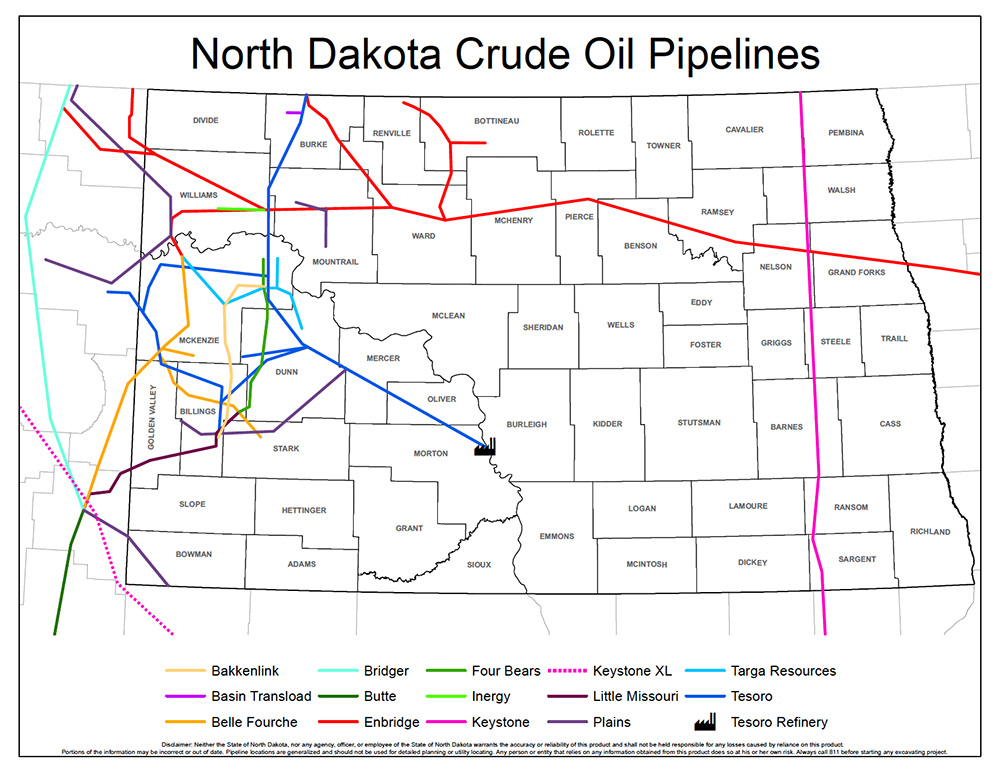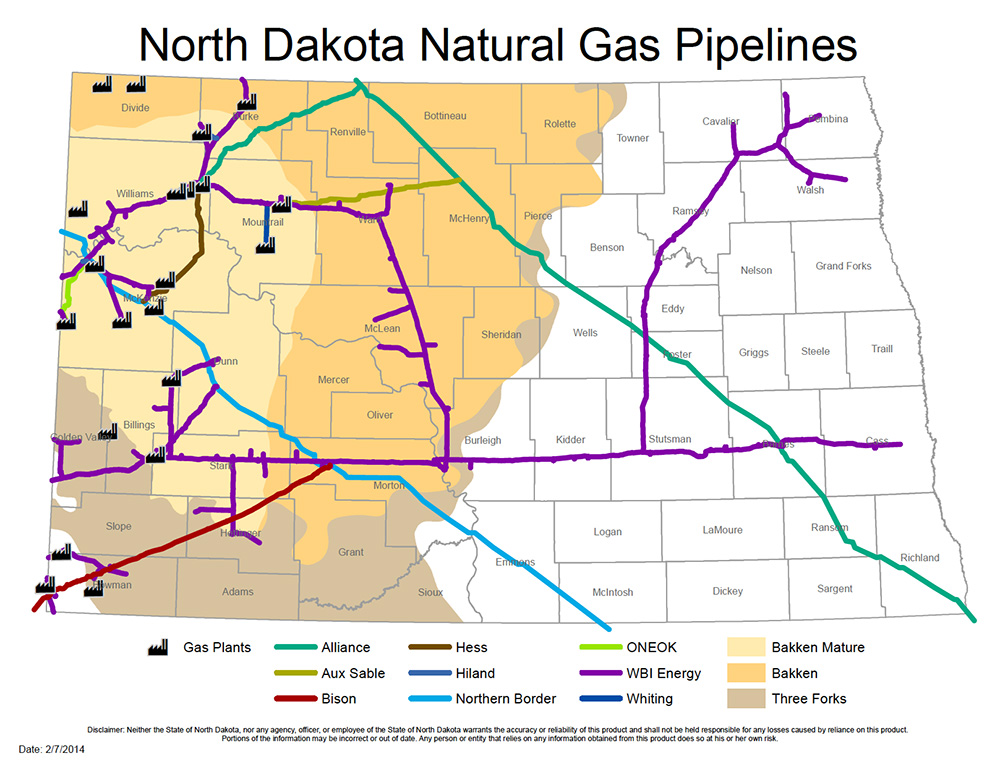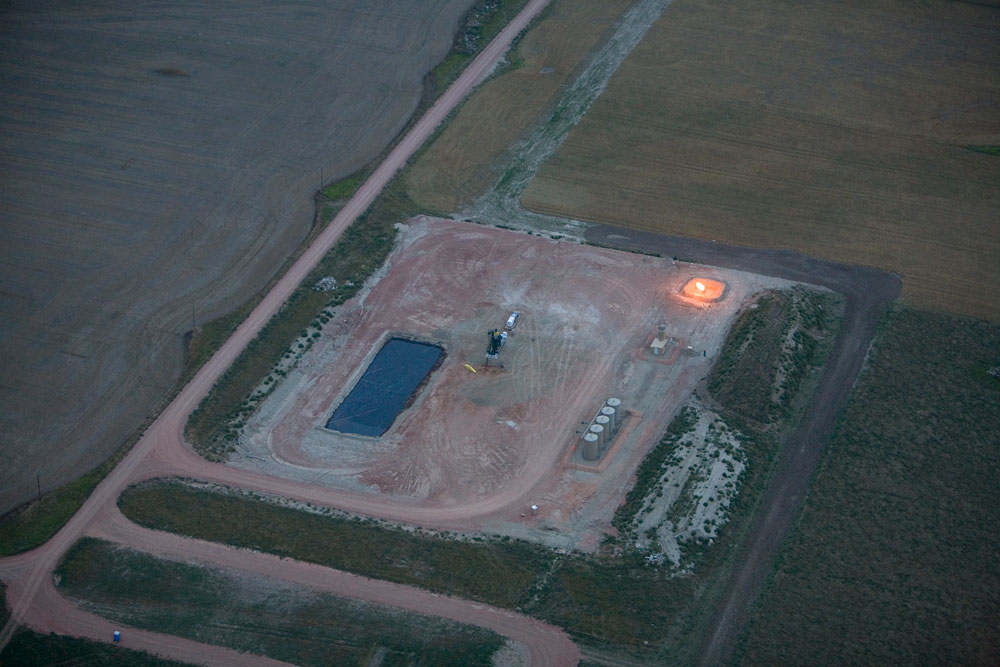
Flare at Night: A natural gas flare at an oil well site as evening falls in North Dakota. Photo courtesy of Vern Whitten Photography.
- Almost 13 percent of the natural gas from North Dakota wells was flared in 2016.
- A shortage of pipelines makes it impossible to transport all of the natural gas from the wells in North Dakota.
- Flaring means burning natural gas that has been captured at the wellhead.
- The gas lost to flaring has improved since 2016, and by 2022 the flaring had been reduced to 6%.
- Flaring occurs for economic reasons: Oil is much easier to store and transport than gas. When oil production begins at the wellhead, the oil can be transported to market in tanker trucks or trains immediately; whereas, infrastructure for gas pipelines might take years to complete.
- Flaring in the Bakken occurs during the time span between when an oil well starts producing and when gas-transport infrastructure is installed.
- Flaring occurs for economic reasons: Oil is much easier to store and transport than gas. When oil production begins at the wellhead, the oil can be transported to market in tanker trucks or trains immediately; whereas, infrastructure for gas pipelines might take years to complete.
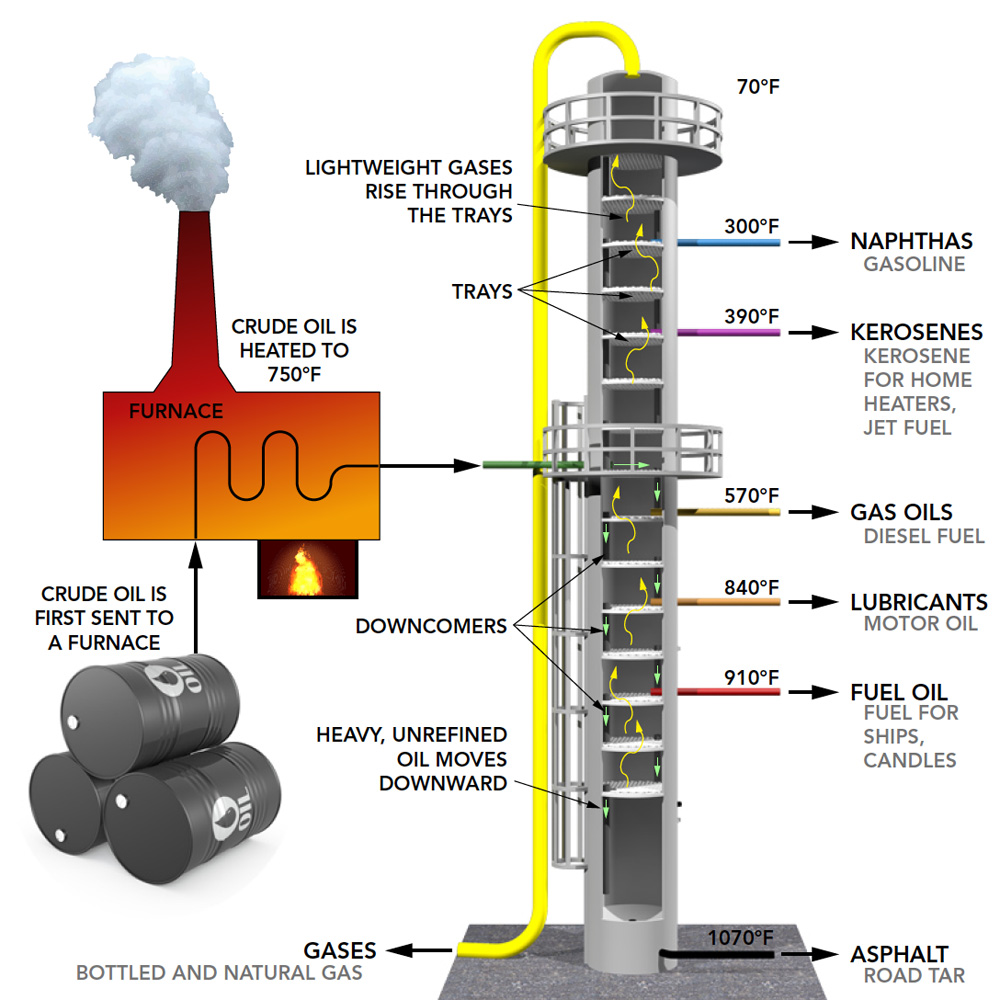
How oil refining works: This diagram of a refinery’s distillation tower shows how the petroleum is heated and separated into different product streams. Graphic courtesy of Bismarck State College National Energy Center of Excellence.
- North Dakota has 18 major petroleum pipelines and 9 major natural gas pipelines.
- The length of these major pipelines and gathering pipelines together equals approximately 30,000 miles – enough pipe to cross the state 88 times!
- An oil refinery cleans and separates petroleum into gasoline, diesel fuel, jet fuel, propane, and other products.
- Refining consists of a combination of fractional distillation and cracking.
- Fractional distillation separates the components of oil into “fractions,” such as light oil or heavy oil, by utilizing their various boiling points and densities as follows:
- Crude oil is heated until it turns to vapor.
- The hot vapor is fed into a pipe still (a tall tower divided by horizontal trays).
- The heaviest fractions cool quickly, condense to liquid, and settle at the bottom; the lighter fractions drift upward and condense at their individual boiling points.
- The substance with the lowest boiling point will condense at the highest point in the tower; the highest boiling point will condense at the lowest level.
- Cracking further splits the fractions into products by using heat and pressure to “crack” heavy, long-chain hydrocarbon molecules into shorter, lighter ones such as those of gasoline.
- Intense heat (about 1,000° F), combined with a special chemical called a catalyst, speeds up the chemical reactions that split the hydrocarbons.
- Some of the hydrocarbons are made into plastics.
- Intense heat (about 1,000° F), combined with a special chemical called a catalyst, speeds up the chemical reactions that split the hydrocarbons.
- Fractional distillation separates the components of oil into “fractions,” such as light oil or heavy oil, by utilizing their various boiling points and densities as follows:
- Refining consists of a combination of fractional distillation and cracking.
- The principal products of petroleum refining are light-weight fractioned energy carriers such as gasoline, diesel fuel, jet fuel, and heating oil.
- Heavier fractions produce tar, asphalt, and heavier oils.
- Oil from the Bakken is a light, “sweet” oil, which means that it is a high-quality oil containing little or no hydrogen sulfide.
- Refiners prefer sweet crude oil because it yields high-value products such as gasoline, diesel fuel, jet fuel, and heating oil.
- Oil from the Bakken is a light, “sweet” oil, which means that it is a high-quality oil containing little or no hydrogen sulfide.
- Heavier fractions produce tar, asphalt, and heavier oils.
- An oil refinery cleans and separates petroleum into gasoline, diesel fuel, jet fuel, propane, and other products.
- The length of these major pipelines and gathering pipelines together equals approximately 30,000 miles – enough pipe to cross the state 88 times!
Gasoline vs. diesel:
- Diesel-powered vehicles generally cost more to buy than similar gasoline-powered vehicles, but the diesels give better fuel economy, or miles per gallon (mpg), than gasoline vehicles.
- The fuel in a gasoline engine is mixed with air, compressed by pistons, and ignited by sparks from spark plugs.
- A diesel engine compresses air in the cylinder, and as the air is compressed, it heats up to a high temperature. When the fuel is injected, it self-ignites. Diesel engines do not need spark plugs.
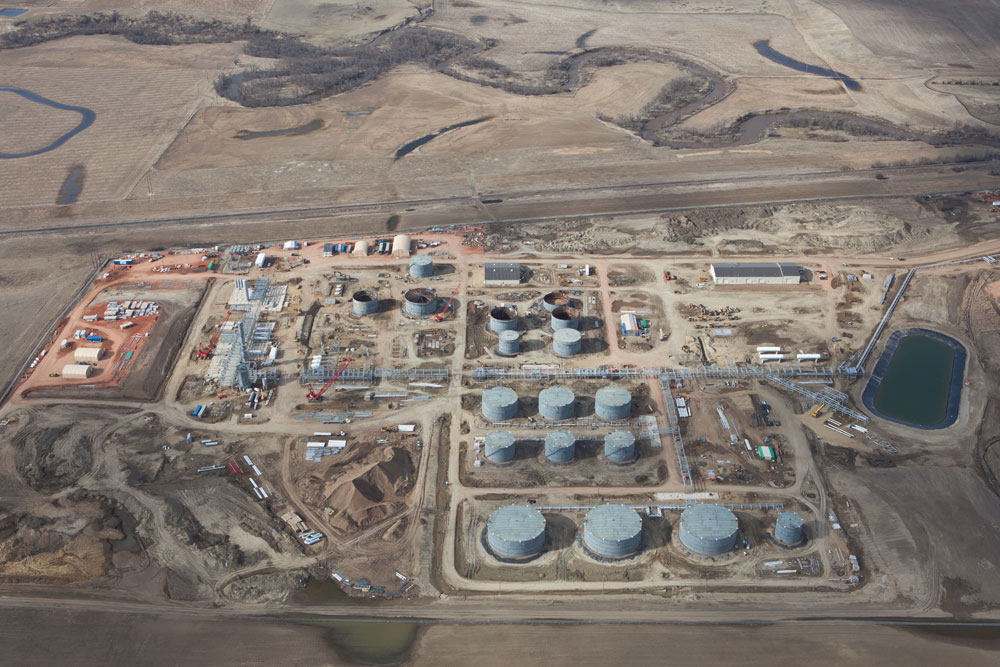
Dakota Prairie Aerial: Diesel fuel will be the primary product of the Dakota Prairie Refinery. This is the first refinery built since 1976. Photo courtesy of MDU Resources.
- North Dakota has two oil refineries owned by Marathon Petroleum.
- The Marathon Petroleum Refinery at Mandan processes North Dakota petroleum into gasoline, diesel fuel, jet fuel, heavy fuel oils, and liquefied petroleum gas.
- Marathon Mandan has a crude oil processing capacity of 71,000 barrels per day (1 barrel = 42 gallons).
- Marathon Mandan processes North Dakota petroleum into gasoline, diesel fuel, jet fuel, heavy fuel oils, and liquefied petroleum gas and transports them by truck, railroad, and pipeline to eastern North Dakota and Minnesota.
- The Marathon Dickinson Refinery was the first refinery to be built in the United States since 1976. The plant primarily produces diesel fuel.
- In 2021 the Marathon Dickinson Refinery was converted to produce 184 million (184,000,000) gallons of renewable diesel a year.
- It is the second largest facility of its kind in the United States.
- It uses Corn Oil and Soybean Oil as the feedstock. The 2 types of oil are blended and then chemically changed into diesel fuel molecules.
- In 2021 the Marathon Dickinson Refinery was converted to produce 184 million (184,000,000) gallons of renewable diesel a year.
- The Marathon Petroleum Refinery at Mandan processes North Dakota petroleum into gasoline, diesel fuel, jet fuel, heavy fuel oils, and liquefied petroleum gas.
- At a natural gas processing plant, natural gas is cleaned, and impurities are separated out.
- Major uses of natural gas include fuel for heating and cooling homes and businesses, cooking, and generating electric power.
- Natural gas is the cleanest burning fossil fuel.
- In order to help reduce pollution, some companies have developed cars, trucks, and buses that can be powered by natural gas.
While natural gas is sold in cubic feet, propane is sold in gallons.
- Propane is a major component of natural gas.
- Propane is also called LP gas (liquid propane gas).
- Other byproducts include butane (used in lighters and mini-torches), ethane (used in the chemical industry), and pentane (used in insulation).
- Propane provides about 2 ½ times the amount of energy per unit of volume than does natural gas.
- Propane is also called LP gas (liquid propane gas).
Heat is measured in British Thermal Units (BTUs), which is the amount of heat needed to raise the temperature of one pound of water by 1° F.
- Natural gas provides about 1,000 BTUs per cu.ft.; for the same volume of propane, about 2,500 BTUs are provided.
- Less propane is needed to produce the same amount of energy as natural gas; however, propane is generally more expensive than natural gas.
- Propane is commonly used in barbecue grills, RVs, and rural home heating.
Because natural gas and propane are odorless, a non-toxic chemical odorant called mercaptan is added, which enables users to detect dangerous leaks from stoves, furnaces, hot water heaters, etc. Mercaptan contains sulfur, which smells like rotten eggs.
- North Dakota has more than 25 natural gas processing plants.
- They are located in the western part of the state in the following counties
- Billings, Bowman, Burke, Divide, Dunn, Golden Valley, McKenzie, Mountrail, Slope, Stark, and Williams.
- They are located in the western part of the state in the following counties



